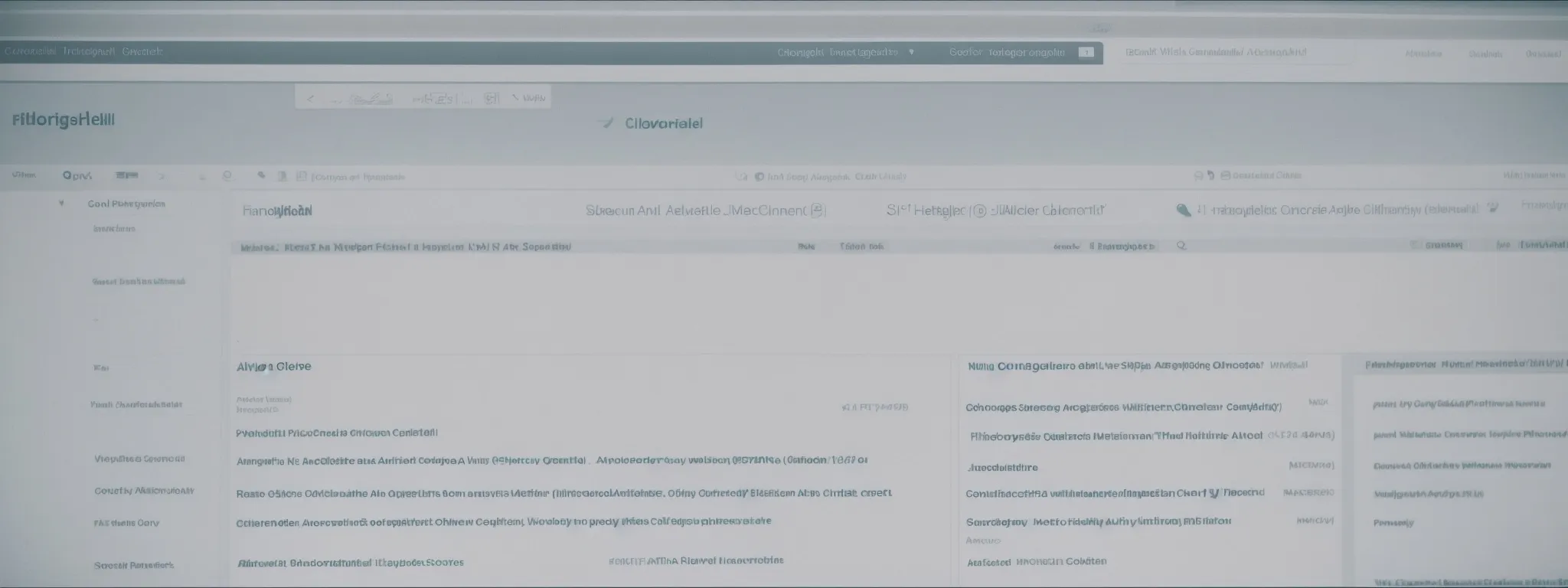SEO Content Checklist
Essential SEO Content Checklist for Optimizing Your Website The digital landscape thrives on content, yet the true challenge lies in forging material that not only captivates readers […]
Essential SEO Content Checklist for Optimizing Your Website
The digital landscape thrives on content, yet the true challenge lies in forging material that not only captivates readers but also satisfies the ever-evolving criteria of search engines.
At the crux of this battle for online visibility are SEO content strategies, meticulously designed to ensure that webpage content does more than inform—it engages, converts, and retains quality traffic.
LinkGraph’s SEO services are cornerstone to polishing your website’s content, enhancing the probability of your pages ranking high in search query results.
This article serves as a compass, guiding you through an SEO content checklist that is imperative for optimizing your website.
Keep reading to discover the key steps in creating SEO-friendly content that resonates with both search engine algorithms and your target audience.
Key Takeaways
- Mastering SEO Involves Aligning Content With Both Searcher Intent and Search Engine Algorithms
- Strategic Implementation of on-Page SEO, Like Optimizing Keywords and Meta Tags, Improves Visibility and User Engagement
- Regular Content Updates and the Utilization of SEO Analytics Tools Are Essential for Maintaining and Enhancing a Website’s SEO Performance
- Internal and External Linking Strategies Bolster a Website’s Authority and User Navigation Experience
- Mobile Responsiveness and Accessibility Best Practices Are Critical Components of a Comprehensive SEO Strategy
Crafting an Intro to SEO for Content Writers

In the realm of digital marketing, mastering the art of Search Engine Optimization (SEO) is a non-negotiable skill for any content writer seeking to amplify their online presence.
An understanding of SEO fundamentals is critical as it lays the groundwork for crafting content that not only resonates with readers but also achieves visibility in search engine result pages (SERPs).
This introduction serves as a beacon for writers ready to navigate the vast waters of key SEO concepts, ensuring that their writing is thoughtfully intertwined with SEO best practices from the onset.
As content creators embark on this journey, they will unravel the nuances of incorporating SEO strategically into their writing practices, propelling their work to the forefront of user searches and driving qualitative page views.
Understanding SEO Fundamentals
Grasping the core principles of SEO is tantamount to unlocking the potential of any webpage content. It equips writers with the insights necessary to align their creative output with the algorithms that power search engines, ensuring that their voice is heard amid the noise of the digital space.
Proficiency in SEO begins with the decoding of a search engine’s mechanics—understanding how it crawls, indexes, and ranks content based on relevance and authority. Such knowledge enables content architects to craft material that resonates with both the searcher’s intent and the stringent criteria of search engine rankings.
Key SEO Concepts for Quality Content
Quality content is the cornerstone of effective SEO, and mastering the interplay between content and search engine algorithms is critical. Writers must ensure that each webpage is optimized with target keywords that mirror the searcher’s query, enhancing the alignment between the user’s needs and the content’s purpose. This strategic placement of keywords bolsters relevance, ensuring a robust connection with target audiences and search engines alike.
Moreover, embedding these target keywords seamlessly into title tags, headers, URL slugs, and meta descriptions fortifies a webpage’s SEO foundation. The deliberate crafting of these elements with both readability and search engine guidelines in mind maximizes the webpage’s potential to climb the ranks of SERPs. Consequently, the content transcends into becoming a valuable asset that attracts quality traffic and retains visitor engagement.
Incorporating SEO in Writing Practices
Incorporating SEO in writing practices requires a meticulous approach, where content writers consider each aspect of their work through the lens of SEO efficacy. Emphasizing the importance of a targeted keyword strategy, content professionals optimize each web page by choosing keywords that reflect the search volume and search intent of the brand’s audience.
Strategic implementation of on-page SEO services, such as optimizing title tags and meta descriptions with primary keywords, becomes instrumental for writers aiming to enhance their webpage content’s visibility and relevance. Such practices, paired with compelling, high-quality writing, ensure that the webpage not only ranks favorably but also offers value that prompts lower bounce rates and higher click-through rates (CTR).
Analyzing Keywords for Content Optimization

In the endeavor to enhance a website’s SEO potential, the analysis of keywords emerges as a primary task for digital content strategists.
Diligently researching and selecting target keywords serves as the bedrock for any seasoned SEO campaign, enabling creators to tailor their content to the queries of prospective customers.
With a deep dive into keyword relevance and difficulty, content specialists, such as those at LinkGraph, pinpoint the most advantageous terms for their projects.
The integration of these keywords into the fabric of online materials, when executed with precision and subtlety, drives both the discoverability and impact of the content.
Such rigorous attention to keyword strategy is not simply about peppering text with search terms; it’s about weaving them organically into the narrative to elevate the content’s authority and engagement in the eyes of both users and search engines.
Researching Target Keywords
Embarking on the quest for the right target keywords necessitates a synergy between data-driven insights and an intimate awareness of the intended audience’s language. Content Specialists at LinkGraph utilize sophisticated tools like Google Keyword Planner to identify keyword ideas that mirror user behavior, ensuring every SEO strategy is underpinned by relevant and high-potential keywords.
When it comes to researching target keywords, precision and foresight are paramount for SEO success; choosing target keywords with high search volume but low competition can exponentially increase a webpage’s visibility. It’s this strategic selection, crafted by the experts at LinkGraph, that positions clients to magnetize their target audience to their web content.
Analyzing Keyword Relevance and Difficulty
Analyzing keyword relevance involves discerning the strength of connection between the search query and the intended content of a webpage. LinkGraph’s SEO services home in on this aspect by evaluating the potential impact of specific keywords on driving targeted traffic to a client’s website, thus enabling a strategic approach that marries searcher intent with content relevance.
Assessing keyword difficulty requires a meticulous examination of the competitive landscape within which a keyword operates. Professionals at LinkGraph utilize their expertise to analyze how challenging it will be to rank for a given keyword, factoring in the authority and SEO efforts of competitors, to ensure clients can effectively compete in the SERPs.
Strategically Placing Keywords in Content
LinkGraph’s SEO services meticulously weave keywords throughout webpage content, ensuring each target keyword is placed with the purpose to maximize search engine visibility and relevance. By embedding these keywords in the body of the text, headers, and even the URL slug, they craft a strategic tapestry that signals both authority and contextuality to search engines.
Effective placement goes beyond mere inclusion; it’s about the density, location, and appropriateness of keywords within the content that defines a successful SEO Content Strategy. LinkGraph utilizes this considered approach, ensuring that the strategic insertion of keywords enhances both the user’s experience and the webpage’s potential for higher SERP rankings.
Optimizing Titles and Headings for Search Engines

Captivating an audience while adhering to SEO principles begins with the meticulous optimization of titles and headings.
As a cornerstone of your essential SEO content checklist, the judicious crafting of titles that pique interest and address search intent, in conjunction with a clear, logical structure maintained through expertly executed headings, is imperative.
Titles that integrate target keywords with a magnetic pull improve both visibility and click-through rates, while a well-organized hierarchy of header tags elevates the readability and search engine understanding of your content.
Through this focus, LinkGraph’s SEO services enhance these crucial elements, ensuring website content is both engaging for the reader and constructed to perform in today’s competitive digital landscape.
Writing Engaging and SEO-Friendly Titles
Articulating a captivating page title is a pivotal step in bridging the gap between compelling webpage content and maximized search engine visibility. LinkGraph’s team of SEO experts prioritize the integration of primary keywords in a title tag, not only to align with search engine algorithms but also to capture the attention and curiosity of the reader.
LinkGraph’s SEO content strategy embraces the delicate balance of creativity and SEO precision, weaving target keywords into titles that spark interest while directly addressing the search intent of potential website visitors. This approach ensures that titles serve as precise indicators of the webpage content, drawing in users and bolstering the page’s position in the search results.
Structuring Content With Appropriate Headings
Strategically Structuring Content with appropriate headings is not merely an exercise in aesthetics; it delineates the narrative flow, thereby enhancing user navigation and comprehension. LinkGraph’s SEO services underscore the significance of using relevant headings to demarcate sections, thus signaling to the search engines the hierarchy and thematic breakdown of the content within a webpage.
Effective use of headings can be instrumental in decreasing website bounce rates and improving engagement: by organizing content under descriptive and keyword-rich subheadings, they make the textual landscape of a webpage easily scannable for both users and search engine crawlers:
- Headings are optimized with target keywords to reinforce topic relevance for search engines.
- Content under each heading is carefully crafted to answer the implied questions from the headings, providing value to the visitor.
- Consistent use of heading tags (H1, H2, H3, etc.) maintains a clear structure, which search engines favor when ranking content.
Moreover, LinkGraph’s meticulous approach to headings ensures that every piece of content is not only optimized for search engines but also caters to the visitor’s quest for information, keeping the user engaged with the content and on the site for longer periods.
Using Header Tags for Hierarchy and SEO
The strategic deployment of header tags is crucial for delineating a clear content hierarchy while concurrently bolstering SEO efforts. LinkGraph’s SEO services provide clients with a content structure optimized for both user comprehension and search engine criteria, ensuring that the usage of , , , and subsequent header tags follows a logical and SEO-driven blueprint.
Search engines rely on header tags to ascertain the thematic focus and organization of web content: recognizing and assessing the varying levels of importance assigned to each section. LinkGraph excels in integrating appropriate header tags to define a content’s structure visibly, emphasizing the concerted approach that underlies both enhanced user experience and searchable content:
- Header tags are meticulously placed to organize content into digestible sections, simplifying navigation for the audience.
- Each tag level, from through to , is employed to set apart headings and subheadings in a hierarchical manner that search engines understand.
- The strategic use of keywords within these headers further amplifies the content’s SEO potential, making it more discoverable to those seeking related information.
Enhancing Content With Meta Descriptions and Tags

An impeccable SEO strategy goes beyond the visible text, delving into the unseen metadata that provides search engines with pivotal insights about a webpage’s content.
Meta descriptions and tags serve as instrumental tools for websites to assert their relevance and bolster their appeal in the algorithmic eyes of search platforms.
This critical layer of optimization not only informs search engines of the content’s context but also entices potential website visitors through carefully curated summaries that appear beneath page titles in search results.
As such, crafting compelling meta descriptions and employing meta tags effectively can decisively elevate a website’s SEO performance, creating a compelling narrative in the vast digital landscape.
Crafting Compelling Meta Descriptions
Meta descriptions act as a concise synopsis for web pages, displayed beneath the page title in search results. A compelling meta description by LinkGraph’s SEO services integrates the primary keyword and delivers a clear value proposition, capturing searcher attention and encouraging clicks.
LinkGraph’s mastery in creating enticing meta descriptions ensures that these brief snippets of text can significantly contribute to a webpage’s click-through rate (CTR) and user engagement. The strategic use of actionable language and persuasive messaging acts as a catalyst for higher organic search traffic.
| SEO Element | Function | LinkGraph’s Strategy |
|---|---|---|
| Meta Description | Site summary for SERPs | Incorporating primary keywords and clear calls to action |
| Primary Keyword | Targeting search queries | Meticulous research and strategic placement |
| CTR Enhancement | Improving page clicks | Optimizing snippet messaging to spur engagement |
Using Meta Tags for Improved SEO Performance
In the context of SEO, meta tags are invaluable in signaling to search engines the essence of a webpage’s content, without necessarily being visible to the visitor. LinkGraph’s SEO services focus on refining these tags, including keyword-rich meta descriptions that are precisely tailored to both reflect the content and entice the reader, effectively boosting the page’s appeal and relevance in SERPs.
Meta keywords, although no longer a major ranking factor, play a subtle role in reinforcing the themes of the webpage content. LinkGraph’s experts employ meta tags judiciously, ensuring tags are relevant and strategically placed to support the content’s overarching SEO goals:
- Meta tags are selected for their precision in reflecting the content’s subject matter.
- Implementation of meta tags adheres to best practices for SEO.
- Every meta tag inclusion works in harmony with other elements to optimize the webpage’s overall SEO health.
Leveraging Internal and External Linking Strategies

A meticulously orchestrated SEO content strategy encompasses more than just keyword placement and captivating titles; it demands a comprehensive understanding of the interconnectivity within and beyond the website.
Crafting a coherent internal link structure is paramount to guiding users through a website’s content, enhancing user experience, and bolstering page authority.
Concurrently, the selective integration of relevant external links opens a portal to the broader digital landscape, signaling to search engines the webpage’s commitment to providing additional value.
LinkGraph’s SEO services emphasize the strategic use of anchor text in these linking practices, threading the critical balance between over-optimization and relevance, to fortify SEO efficacy and pave the way for an optimized website that stands out in search engine result pages (SERPs).
Building Effective Internal Link Structures
Effective internal link structures weave a web of navigational ease, with LinkGraph’s SEO services expertly anchoring each connection to ensure content is interlinked in a manner that not only aids in user experience but also assists with website crawling and indexing. By ensuring that links are contextually relevant and contribute meaningfully to the topic at hand, internal link structures lend a subtle yet direct trajectory towards higher Web content relevancy and authority within the digital arena.
Moreover, LinkGraph’s approach to internal linking transcends the mere act of connection, embedding strategic links that serve as conduits for page authority to be evenly distributed across a client’s digital property. This uniform dispersal of page authority garners a fortified presence in SERPs, laying a robust foundation upon which a website’s SEO health can thrive and evolve.
Incorporating Relevant External Links
In the intricate tapestry of SEO, incorporating relevant external links serves as both a hallmark of credibility and an open-handed gesture towards other authoritative domains. Through this practice, LinkGraph’s SEO services carefully select and integrate links to reputable external resources, bolstering the article’s validity and encouraging reciprocal professional relationships that may lead to beneficial backlink opportunities.
Securing a foothold in the broader digital ecosystem, LinkGraph’s strategic use of external links extends the user’s journey beyond the confines of a single website, inviting exploration while signaling to search engines the depth and breadth of research deployed in web content creation. This enhances a website’s standing as a hub of information, organically attracting a discerning audience and positively impacting search rankings.
Using Anchor Text Strategically
LinkGraph’s SEO services approach anchor text with meticulous strategy, fully understanding its role as a navigational guide not just for users, but also for search engines. The right choice of anchor text boosts the relevancy of linked content and can play a pivotal role in the interlinking structure’s contribution to the SEO health of the website.
Expertly selecting the appropriate anchor text, LinkGraph ensures that the combination of keywords optimizes the connected pages’ potential to rank, avoiding overuse that could detract from the user experience or trigger search engine penalties. This strategic placement acts as a subtle yet powerful lever in enhancing the search visibility of the website’s content.
Employing Image Optimization Techniques

In the dynamic landscape of SEO, visual elements play a pivotal role in the overall optimization strategy for a website.
Employing image optimization techniques stands as a critical measure to enhance webpage speed, improve search engine rankings, and deliver an optimal user experience.
Effective image optimization begins with the careful selection of visually appealing images that complement the written content, continues through the meticulous process of compressing images to maintain site performance without sacrificing quality, and extends to the strategic addition of descriptive alt text, which fortifies the accessibility and SEO value of the images.
Together, these practices form a crucial part of the comprehensive SEO content checklist necessary for any website aiming to compete in the digital arena.
Choosing the Right Images
Selecting the optimal images for web content transcends mere aesthetic judgment; it engages with the subtleties of branding and contextual relevance. LinkGraph’s SEO services prioritize this selection process, ensuring images not only enrich the page aesthetically but also resonate with the brand messaging and elevate the overall narrative of the content, thereby creating a cohesive user experience that aligns with the brand’s vision.
Furthermore, the decision-making mosaic of image selection by LinkGraph involves an attentive assessment of the image’s impact on page speed and responsiveness. Recognizing the powerful correlation between page performance and user engagement, LinkGraph’s methodical approach ensures that each selected image is optimized for rapid loading across all devices, subtly nurturing a positive visitor perception and enhancing the site’s SEO metrics.
Compressing Images Without Losing Quality
LinkGraph’s SEO services recognize the intricate balance between image quality and load time—a critical factor in page speed optimization. The expert team employs advanced compression algorithms designed to reduce image file sizes significantly while retaining their visual integrity, ensuring the seamless integration of high-definition visuals that do not impede website performance.
Incorporating cutting-edge tools and techniques, LinkGraph maximizes image efficiency, which is fundamental in maintaining swift page load times and improving user experience on a website. Recognizing this, they meticulously compress images, a step which has proven indispensable in enhancing both the aesthetic appeal and SEO potential of a client’s digital presence.
Adding Alt Text to Images for SEO
Adding alt text to images is an SEO task that serves a dual purpose: it ensures web content is accessible to users who may rely on screen readers and also provides search engines with contextual information. LinkGraph’s SEO services meticulously craft descriptive, keyword-rich alt text that enhances image discoverability in search engine result pages, reiterating the page’s relevance and authority on a given subject.
LinkGraph’s approach to adding alt text transcends mere compliance; it’s an art that links SEO finesse with user inclusivity. Each image’s alt tag is composed with the goal of contributing qualitative SEO benefits while accurately describing the image’s content and function, fostering a more engaging and accessible web experience for all website visitors.
Ensuring Mobile Responsiveness and Accessibility

In the fast-paced, mobile-first digital landscape, optimizing a website with a mobile-responsive design and adherence to accessibility best practices is no longer optional; it is imperative.
Website designers and content creators must ensure that their digital offerings are both accessible and user-friendly across a spectrum of devices, thereby safeguarding equitable access and a seamless user experience.
This commitment not only aligns with inclusive design principles but also reinforces a website’s standing in search engine evaluation metrics, positioning content to capture the widest possible audience.
Designing Content for Mobile Users
Designing content for mobile users necessitates an approach where ease of navigation and readability are paramount. LinkGraph’s SEO services prioritize mobile-first design, ensuring web pages are impeccably crafted to deliver an intuitive and seamless experience on smaller screens, enhancing engagement and contributing to improved SEO rankings.
Understanding that user interaction on mobile differs significantly from desktop behavior, LinkGraph leverages responsive design techniques to create content that adapts fluidly to various screen sizes. This attention to mobile responsiveness not only caters to the user’s needs but also signals to search engines the website’s commitment to providing an accessible platform, thus boosting its favorability in search algorithms.
Implementing Accessibility Best Practices
Implementing Accessibility Best Practices is an intrinsic part of LinkGraph’s SEO services, ensuring that web content is usable by individuals with diverse abilities. By adhering to established guidelines such as the Web Content Accessibility Guidelines (WCAG), LinkGraph prioritizes the creation of content that is perceivable, operable, understandable, and robust for all users.
Accessibility not only broadens the reach to include users with disabilities but also positively influences SEO efforts by enhancing the site’s usability and user experience. LinkGraph’s commitment to accessibility underscores an inclusive digital strategy that aligns with ethical standards and search engine preferences:
| SEO Focus | Accessibility Component | Impact on SEO |
|---|---|---|
| Content usability | Adherence to WCAG | Extended reach and improved user experience |
| Inclusive digital presence | Perceivable, operable web elements | Enhanced engagement and site credibility |
Amplifying Content Reach With Social Media Integration

In today’s interconnected digital ecosystem, social media platforms serve as powerful amplifiers for website content, extending its reach beyond the confines of traditional search.
By seamlessly integrating social sharing capabilities and fostering engagement on these networks, brands can not only heighten their content’s visibility but also enhance its potential for virality.
This strategic interplay between SEO and social media maximizes the opportunities for content to resonate with a broader audience while driving meaningful interactions that contribute to overall digital marketing success.
Sharing Content on Social Platforms
In the realm of SEO, content does not thrive in isolation; social media platforms present vital channels for content distribution and audience growth. Leveraging these platforms allows website owners to facilitate content sharing, significantly expanding their reach and fostering deeper connections with their audience.
Understanding the power of social signals and their indirect impact on search rankings, LinkGraph’s SEO services integrate social sharing features within web content, thus inviting engagement that can amplify visibility across networks. This integration grants content the wings it needs to soar across the digital landscape, engaging users where they are most active:
- Critical social sharing buttons are strategically embedded to make sharing intuitive for the user.
- Content formats and messaging are tailored to perform well within the algorithmic frameworks of prominent social platforms.
- Active monitoring of social interactions informs ongoing adjustments to content strategy, maximizing its shareability and impact.
Encouraging Social Engagement
LinkGraph’s approach to SEO includes fostering interactive communities via social media, as this can be instrumental in creating a robust online presence. Establishing open lines of communication and actively engaging with comments, shares, and feedback transforms passive viewers into active participants and brand advocates.
With an emphasis on user involvement, LinkGraph encourages the creation of shareable, discussion-provoking content that stimulates conversation and drives traffic back to the website. This social dialogue not only reinforces user relationships but also signals to search engines the content’s vitality, contributing to its organic ranking trajectory.
Keeping Content Fresh With Regular Updates

A dynamic website that delivers relevance and value to its audience is frequently refreshed with current information and insights, ensuring that its content remains a trusted resource in an ever-evolving digital arena.
It is imperative for website owners to routinely revisit their existing content, injecting new life into outdated material and enhancing the relevancy of their website within search engine algorithms.
This practice not only maintains a high level of audience engagement by providing fresh perspectives but also signals to search engines a commitment to quality and up-to-date information, two elemental drivers of SEO performance.
The importance of this upkeep cannot be overstated—it is an ongoing task that supports the strength and authority of the brand’s online presence.
Reviewing and Updating Outdated Content
LinkGraph’s SEO services recognize the necessity of maintaining a website with up-to-date and relevant information. Periodic review and refurbishment of web content ensure that all information reflects the latest industry trends, regulatory changes, and technological advancements, thereby fortifying the website’s authority and trustworthiness in its respective field.
By revisiting and refining older content, LinkGraph delivers a strategized freshness that can directly influence a website’s search engine rankings. This process involves not only updating facts and figures but also reassessing the SEO elements, such as keyword distribution and meta tags, to align with evolving search behaviors and algorithm updates.
Adding New Insights and Information
Injecting new insights and information into web content stands essential, not only to captivate the reader’s interest but also to signal a website’s relevancy and topical authority to search engines. By consistently incorporating the latest data, commentary, and industry-specific knowledge, LinkGraph’s SEO services maintain a brand’s competitive edge both for human curiosity and algorithmic favorability.
This commitment to content currency and precision ensures that every website under LinkGraph’s care acts as a beacon of up-to-date knowledge, attracting a discerning audience keen on cutting-edge information. It is this perpetual refinement that underscores the value offered to both client and customer:
| Content Element | Update Strategy | SEO Impact |
|---|---|---|
| Data and Statistics | Regular refreshment with new findings | Enhanced topical relevance and authority. |
| Industry Commentary | Inclusion of expert insights and trends | Increased engagement and content credibility. |
Tracking Results With SEO Analytics Tools

In the intricate dance of search engine optimization, mere implementation of strategies is not sufficient; it’s the analysis and adaptation that drives enduring success.
A robust suite of SEO analytics tools is indispensable for content creators who aim to monitor and elevate the performance of their digital assets.
Engaging actively with data-driven insights enables a website to adjust and refine its approach, ensuring that the needle moves progressively towards enhancing keyword rankings, interpreting user behaviors, and evolving strategies to align with tangible performance metrics.
This alignment fosters a strategic edge poised to respond to the ever-changing SEO landscape, propelling website optimization to new heights.
Monitoring Keyword Rankings
In today’s digital marketing realm, the vigilance over keyword rankings is a paramount aspect of LinkGraph’s SEO services. By leveraging advanced SEO analytics tools, LinkGraph consistently monitors fluctuations in keyword positions, garnering immediate insights into the effectiveness of content strategies.
LinkGraph’s focus on keyword rankings extends beyond mere visibility; it’s about understanding the searcher’s journey from query to click. This data reflects user preferences and behavior, allowing for agile, informed adjustments to SEO tactics:
- Evaluating the performance of targeted keywords against competitors.
- Identifying opportunities for content optimization based on ranking trends.
- Adjusting SEO strategies swiftly in response to ranking shifts.
Analyzing Traffic and User Engagement
Analyzing traffic and user engagement is crucial for assessing the impact of SEO content on website performance. LinkGraph’s SEO services employ sophisticated analytics to scrutinize patterns and depths of user interaction, from the average session duration to the actions triggered by each visitor.
- Gauging the efficacy of content in retaining visitor interest.
- Optimizing webpage elements to improve user journey analytics.
- Refining content strategies to foster higher levels of engagement.
Diligent assessment of traffic sources and engagement metrics allows LinkGraph to fine-tune SEO strategies that attract and captivate the right audience. The resulting insights inform decisions from content creation to layout adjustments, driving enhancements in attracting and sustaining quality traffic to clients’ websites.
Adapting Strategies Based on Data Insights
Data insights serve as the compass guiding SEO strategy refinement. Armed with analytics, LinkGraph’s SEO experts continually reshape their optimization tactics, ensuring every element of webpage content aligns with the evolving dynamics of search algorithms and user behavior patterns.
By proactively responding to the insights unearthed from data analysis, LinkGraph ensures that clients’ SEO strategies remain agile and effective, promptly adapting to market shifts and user trends to maintain and enhance digital presence and performance.
Conclusion
In conclusion, implementing an essential SEO content checklist is paramount for optimizing your website and bolstering its online presence.
Key components such as keyword-centric titles and headings, engaging meta descriptions, strategic internal and external linking, and the smart use of images and alt text all converge to drive higher search engine rankings and improve user engagement.
Moreover, maintaining mobile responsiveness and accessibility ensures a wider reach and user satisfaction.
By actively integrating social media, regularly refreshing content with current information, and employing SEO analytics for informed strategy adjustments, a website can thrive in the competitive digital landscape.
Embrace these SEO best practices to ensure that your website stands out, attracts quality traffic, and delivers a compelling user experience.














































































